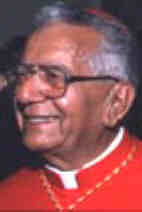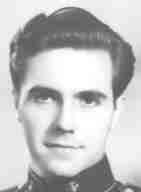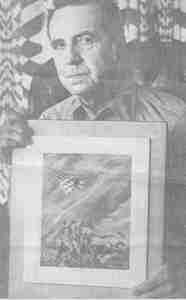|
|
|
| <<
Mar 06| HISTORY
“4” “2”DAY
|Mar 08 >> Events, deaths, births, of MAR 07 [For Mar 07 Julian go to Gregorian date: 1583~1699: Mar 17 — 1700s: Mar 18 — 1800s: Mar 19 — 1900~2099: Mar 20] |
| On a March 07:
2002 Saudi surgeons' attempt to be on the cutting edge of progress: the International Journal of Gynecology and Obstetrics reports on the world's first uterus transplant, performed by Dr. Wafa Fageeh, Dr. Hassan Raffa, Dr. Hussain Jabbad and Dr. Anass Marzouki, of the King Fahd Hospital and research center in Jidda, Saudi Arabia in April 2000. Before operating, the team practiced on 16 baboons and 2 goats. The operation is difficult because the blood vessels that have to be sewn together are tiny, much smaller than those in other organ transplants. In fact the blood circulation failed and the uterus had to be removed after 99 days. The advisability of such an operation is questionable, because: 1– it is not a life-saving procedure; 2– a transplanted organ requires potent anti-rejection drugs which might be harmful to a foetus.
|
||||||
| 2000 President Hafez Assad of Syria has the govenment
of Mahmoud el-Zouebi resign and names Mohammed Mustafa Miro, governor of
Aleppo province, as the new prime minister, charged with forming a new government.
2000 The Nasdaq composite index goes above 5000 intraday. 1999 El partido Democrático de Guinea Ecuatorial (PDGE), del presidente Teodoro Obiang Nguema Mbasogo, consigue 75 de los 80 escaños de la Cámara de Representantes de Pueblo, en las segundas elecciones legislativas desde la independencia del país. 1999 El Gobierno de Ucrania decide poner en marcha el tercer reactor de la central nuclear de Chernóbil, con la consiguiente preocupación de Occidente, temeroso de sufrir un nuevo desastre nuclear. 1999 Francisco Guillermo Flores Pérez, candidato a la presidencia de El Salvador por la derechista Alianza Republicana Nacionalista (ARENA), vence en las elecciones presidenciales con un 51,98% de los votos. 1998 En medio de las protestas de los ciudadanos y de los partidos políticos en Chile, el criminal general Augusto José Ramón Pinochet Ugarte es nombrado "comandante en jefe benemérito" del Ejército, en reconocimiento a su mando dictatorial de más de 24 años. 1997 Estados Unidos veta el borrador de una resolución del Consejo de Seguridad de la ONU elaborado por la UE contra los planes israelíes de construir un barrio judío en Jerusalén oriental.
1994 The Supreme Court rules that parodies that poke fun at an original work can be considered "fair use" that doesn't require permission from the copyright holder. 1989 Partial eclipse of the Sun (Hawaii, NW North America, Greenland) 1988 Intento fracasado de golpe de Estado contra el Presidente de Santo Tomé y Príncipe por el Santo Tomé y Príncipe (FNRSTP). 1977 Israeli PM Yitzhak Rabin meets Pres Carter 1975 The US Senate revises filibuster rule, it now allows 60 senators to limit debate in most cases, instead of the previously required two-thirds of senators present.
1972 In the biggest air battle in Vietnam in 3 years, US jets battle 5 North Vietnamese MiGs and shoot one down 275 km north of the Demilitarized Zone. The 86 US air raids over North Vietnam in the first two months of 1972 equaled the total for all of 1971. 1972 El cardenal Vicente Enrique y Tarancón es elegido presidente de la Conferencia Episcopal Española. 1971 Egypt refuses to renew the Suez ceasefire. |
1965 A march by civil rights demonstrators is broken up in Selma, Alabama, by state troopers and a sheriff's posse.
|
1941 British troops invade Italian-held Abyssinia (Ethiopia)
1931 Los obispos alemanes de la provincia eclesiástica de Colonia advierten de los peligros del nacionalsocialismo. 1930 Mohandas Karamchand Gandhi inicia la "marcha de la sal". 1926 First transatlantic radio-telephone call (London-New York) 1925 Mongolia Exterior es ocupada por el Ejército Rojo de la URSS. 1921 Are made cardinals: Juan Benlloch y Vivó [29 Dec 1864 – 14 Feb 1926]
1911 The US sends 20'000 soldiers to the Mexican border as a precaution because of the Mexican Revolution. |
1862 Siege of New Madrid, Missouri continues 1861 Pruebas satisfactorias del submarino de Monturiol "Ictíneo" en aguas de Alicante, aunque el inventor no consiguió apoyo oficial. 1850 In a 3-hour speech to the US Senate, Daniel Webster endorses the Compromise of 1850 as a means of preserving the Union. 1848 In Hawaii, Great Mahele (division of lands) signed 1847 US General Scott occupies Vera Cruz Mexico 1836 En la guerra contra Texas, fin de la Batalla del Álamo. El general mexicano López de Santa Anna toma el fuerte de El Álamo, en San Antonio de Béjar, Texas. Santa Anna ordena fusilar a todos los sobrevivientes. 1822 Ante la negativa de los gobernadores españoles de las Californias (la Alta y la Baja), de no reconocer la Independencia de México, el alférez José María Mata y el alcalde de Loreto, Baja California, aprovechan el ataque del filibustero inglés Thomas Cochrane a San José del Cabo, y organizan la resistencia, logrando vencerlo, situación que les permite acaudillar al pueblo y proclamar la Independencia de México en esa provincia. 1793 La Convención Nacional francesa declara la guerra a España por su adhesión al ya ejecutado monarca Luis XVI. 1778 Capt James Cook first sights Oregon coast, at Yaquina Bay 1774 British close port of Boston to all commerce 1638 Controversial colonial churchwoman Anne Hutchinson, 47, and nineteen other exiles from the Massachusetts Bay Colony settle in Rhode Island, at the site of modern Portsmouth. |
| 1940
Day 97 of Winter War: USSR aggression against Finland. ^top^ More deaths due to Stalin's desire to grab Finnish territory. Attacking Russian force destroyed in Sintolanniemi Following preliminary artillery fire, the Soviet force on the Isthmus launches an assault and breaks through the Finnish backline positions in Tali, advancing thereafter in the direction of Tali village. The Soviet troops make several local breakthroughs, which are successfully contained. A new group, the Hamina Group, is formed to give added strength to the defence of Viipurinlahti bay. The command of the new group is entrusted to Major-General E. Hanell, who is to be directly responsible to Commander-in-Chief Mannerheim. In Taipale, an enemy battalion attacks the Terenttilä stronghold. Finnish losses on this comparatively quiet day in Taipale are 10 dead and 35 wounded. The attacking Russian force in the Sintolanniemi sector is completely destroyed. In Ladoga Karelia, Detachment Alfthan cuts the supply lines of the Soviet troops in Lavajärvi village. The enemy launches yet another attack in the Kollaa sector. The 69th Infantry Division nevertheless manages to hold its ground. In the far north, a Red Army regiment overruns the Finnish defensive positions at Nautsi in Petsamo. Nautsi's one and only house is raised in the Soviet Union's war bulletin to the status of "the town of Nautsi". Detachment Pennanen's losses in Petsamo total 33 dead, 87 wounded and 67 missing in action. Abroad: Finland's delegation to the Moscow peace talks arrives in the Russian capital in the early evening. British volunteers swear their oath to Colonel Kermit Roosevelt in the Finnish Aid office in London. Venäläiset hyökkääjät tuhotaan Sintolanniemen lohkolla Talvisodan 99. päivä, 07.maaliskuuta.1940 ^top^ Neuvostojoukot aloittavat hyökkäyksen tykistön rumputulella ja tunkeutuvat taka-aseman läpi Talin kannaksella ja alkavat edetä Talin kylän suuntaan. Neuvostojoukot tekevät lukuisia sisäänmurtoja, jotka saadaan rajoitetuiksi. Viipurinlahden puolustustaistelujen tehostamiseksi perustetaan suoraan ylipäällikkö Mannerheimin johtoon uusi yhtymä, Haminan Ryhmä, jonka komentajaksi määrätään kenraalimajuri E. Hanell. Taipaleessa pataljoonan vahvuinen vihollinen hyökkää Terenttilän tukikohtaa vastaan. Suomalaistappiot Taipaleessa jäävät rauhallisen päivän aikana 10 kaatuneeseen ja 35 haavoittuneeseen. Venäläiset hyökkääjät tuhotaan Sintolanniemen lohkolla. Osasto Alfthan katkaisee Lavajärven kylässä olevien neuvostojoukkojen huoltoyhteydet. Kollaan alueella vihollinen aloittaa jälleen uuden hyökkäyksen. JR 69 kykenee pitämään asemansa. Neuvostoarmeijan rykmentti valtaa Nautsin puolustusasemat Petsamossa. Nautsin ainut talo korotettiin Neuvostoliiton sotatiedotuksessa "Nautsin kaupungiksi". Osasto Pennasen tappiot Petsamon taisteluissa ovat kaikkiaan33 miestä kaatuneina, 87 miestä haavoittuneina ja 67 miestä kadonneina. Suomen rauhanneuvotteluvaltuuskunta saapuu Moskovaan illansuussa. Ulkomailta: Brittiläiset vapaaehtoiset vannovat valansa eversti Kermit Rooseveltille Suomen Avun toimistossa Lontoossa. Ryska inkräktare förintas på avsnittet i Sintolanniemi Vinterkrigets 99 dag, den 07 mars 1940 ^top^ De ryska trupperna inleder ett anfall med trumeld av artilleriet och tränger igenom den bakre ställningen på Tali näs. Därefter rycker de fram mot Tali by. De ryska trupperna lyckas göra flera inbrytningar, som finnarna dock lyckas begränsa. För att effektivera försvarsstriderna vid Viborgska viken grundas en ny grupp, Fredrikshamnsgruppen, som lyder direkt under överbefälhavare Mannerheim. Generalmajor E. Hanell utnämns till kommendör för gruppen. I Taipale anfaller fienden med en bataljon mot basen i Terenttilä. De egna förlusterna i Taipale är 10 stupade och 35 sårade denna lugna dag. Ryska inkräktare förintas på avsnittet i Sintolanniemi. Avdelning Alfthan skär av de ryska truppernas försörjningsförbindelse i Lavajärvi by. Vid Kollaa inleder fienden en ny offensiv. JR 69 lyckas hålla positionen. Ett regemente i den ryska armén erövrar försvarsställningen i Nautsi, Petsamo. Den enda byggnaden i Nautsi beskrivs i en rysk krigsrapport som "Nautsi stad". Avdelning Pennanens förluster i Petsamostriderna är inalles 33 stupade, 87 sårade och 67 försvunna soldater. Finlands fredsförhandlingsdelegation anländer till Moskva på kvällen. Utrikes: Brittiska frivilliga svär eden inför överste Kermit Roosevelt på Finlandshjälpens kontor i London. |
| 1938 788 hombres, en el hundimiento del crucero Baleares,
durante la Guerra civil española. 1932 Aristide Briand, estadista francés. 1931 Theo van Doesburg, Dutch Neo-Plasticist painter born in 1883 — LINKS — Composition XI — Composition XXII — Countercomposition — Simultaneous Countercomposition 1908 Manuel Curros Enríquez, escritor español. 1890 Claudio Moyano Samaniego, político español. 1868 George St. Leger Grenfel, 68, former Confederate colonel, cellmate Johnny Adare, a prison guard, and two other inmates, as they escape from the Fort Jefferson prison, off Florida's Gulf Coast, in a small fishing boat into a storm in which they disappeared forever.
1724 Inocencio XIII, Papa. 1274 Saint Thomas Aquinas, 48, applied Aristotle's philosophy to theology. — AQUINAS ONLINE: Summa Theologica — Corpus Christi — Epistola de Modo Studendi — De Ente et Essentia — De Principio Individuationis — (in English translations): — Summa Theologica — Summa Theologica — Of God and His Creatures (abridged Summa Contra Gentiles) — On Being and Essence — On the Eternity of the World — On the Principles of Nature . 0161 Antonino Pío, emperador romano.
|
||||||||
 Births
which occurred on a March 07: Births
which occurred on a March 07: 1948 Juan Eslava Galán, escritor y profesor español. 1936 Julio Terrazas Sandoval, C.SS.R., Bolivian Redemptorist ordained priest on 29 July 1962, appointed auxiliary of La Paz on 15 April 1978 and consecrated bishop on 08 June 1978; appointed bishop of Oruro on 09 January 1982 and archbishop of Santa Cruz on 06 February 1991; made cardinal on 21 February 2001. 1933 "Monopoly" game, invented. |

 1925 René
Gagnon, Manchester, NH. ^top^
1925 René
Gagnon, Manchester, NH. ^top^[< young René Gagnon] He would be one of the six flag raisers on top of Mount Suribachi, Iwo Jima, on 23 February 1945, immortalized in the famous photo. René Gagnon was the youngest of the three flag raisers who survived the Iwo Jima campaign. He was the man who carried the flag up Mt. Suribachi. He was the first survivor to arrive back in the US. René Gagnon died in Manchester NH on 12 October 1979. [René
Gagnon in later years >] |
1887 Helen Parkhurst, US educator, author, and lecturer who died on 01 June 1973. 1886 Federico García Sanchiz, escritor español. 1885 La vida alegre y muerte triste, del dramaturgo José de Echegaray Eizaguirre, se estrena.
|
| 1872 Pieter
Cornelis Mondriaan “Piet Mondrian”, Dutch painter,
who carried abstraction to its furthest limits. Through radical simplification
of composition and color, he sought to expose the basic principles that
underlie all appearances. — Nederlands
biografie — MORE
ON MONDRIAN AT ART “4” MARCH —
LINKS
— River
View with Boat — Molen
(Mill); Mill in Sunlight —
Avond (Evening); Red Tree — Amaryllis
—
Gray Tree —
Composition No. II; Composition in Line and Color —
Ocean 5 —
Composition with Color Planes and Gray Lines 1 —
Composition with Gray and Light Brown —
Composition A: Composition with Black, Red, Gray, Yellow, and Blue —
Lozenge Composition with Yellow, Black, Blue, Red, and Gray —
Composition with Large Blue Plane, Red, Black, Yellow, and Gray
—
Composition with Red, Yellow and Blue — Composition
with Blue, Yellow, Black, and Red —
Lozenge Composition with Red, Black, Blue, and Yellow — Fox
Trot; Lozenge Composition with Three Black Lines —
Composition with Yellow Patch —
Composition with Yellow — Composition
No. III Blanc-Jaune —
Rhythm of Black Lines —
Composition blanc, rouge et jaune —
Vertical Composition with Blue and White —
Composition No. 8 —
Composition No. 10 —
New York City —
Broadway Boogie Woogie — Solitary
House— Little
Girl — Still
Life with Gingerpot II — Composition
with Oval in Color Planes II — Self
Portrait — Composition
with Grid VII (Lozenge) — Composition
with Grid IX — Composition
A — Composition
with Black, Red, Gray, Yellow, and Blue — Lozenge
Composition with Red, Gray, Blue, Yellow, and Black — Place
de la Concorde — New
York City I — Victory
Boogie Woogie 1857 Julius Wagner von Jauregg, Austrian psychiatrist and neurologist (Nobel 1927). He died on 27 September 1940. 1850 Tomas Masaryk, founder and president of Czechoslovakia who died on 14 September 1937. 1811 Giuseppe Ferrari, Italian historian, political philosopher, and politician who died on 02 June 1876. He is best known for his study of Roman and Italian revolutions. [He did not design, manufacture, nor race automobiles, which had not been invented. That was Enzo Ferrari (18 Feb 1898 – 14 August 1988)].
1744 or 1752 Jean-Louis Demarne (or de Marne), French painter who died on 24 March or January 1829. — MORE ON DEMARNE AT ART “4” MARCH — Foire à l'Entrée d'un Village — Une Route — Women and Soldiers Revelling (1787, 49x57cm) — The Elixir (49x60cm) 1672. Francisco Javier Solchaga, en la ciudad de Querétaro. El habrá de distinguirse como consumado teólogo, orador, filósofo, misionero y hombre de ciencia. Ha de morir en la ciudad de Puebla, el año de 1757. |
| What is the technical term for “military intelligence”? — oxymoron. |